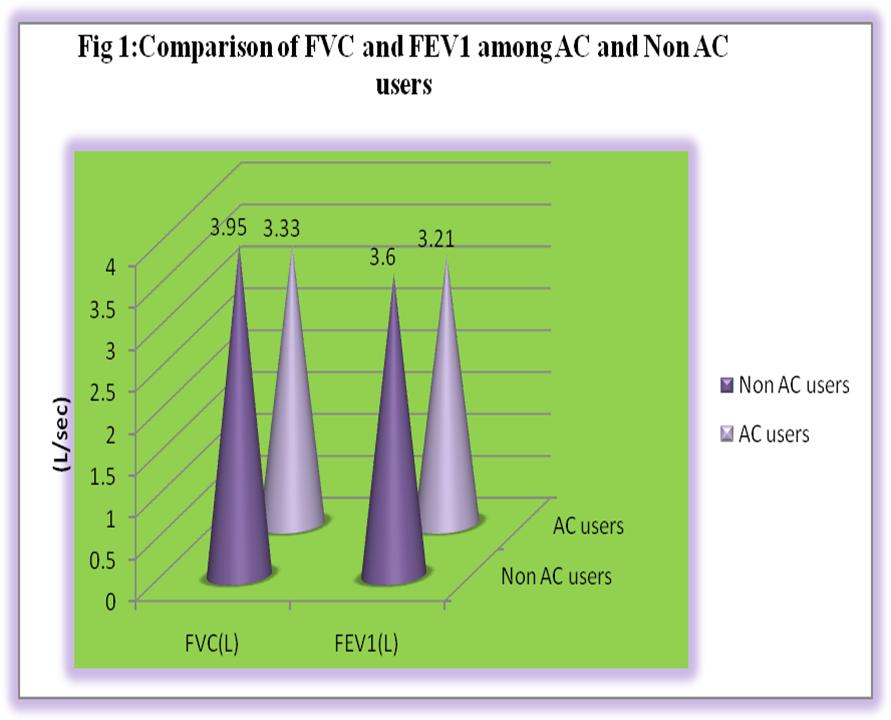
Impact of Chronic Air Conditioner usage on Pulmonary Function Tests using Computerised Spirometry in Healthy Males in Coimbatore.
Abstract
Background: Nowadays, Air conditioners are one of the most luxurious needs of human beings and their use has been increasing day by day. According to recent studies, inhalation of cold dry air leads to alteration in pulmonary functions. The present study was aimed at considering whether intensive use of air conditioner affected pulmonary functions.
Materials and Method: 25 male subjects having age group of 18-25 years and using air conditioners for more than 6 months and for a minimum duration of 6 hours per day were selected for the study. 25 males of same age group who never use air conditioners were taken as control. In all the subjects, computerized spirometric parameters were measured by SPIRO EXCEL. The parameters between both the groups were compared by applying unpaired ‘t’ test. P value less than 0.05 was taken as statistically significant.
Results: There was statistically significant reduction in FVC(Forced Vital Capacity), FEV1(Forced Expiratory Volume in first second), FEV1/FVC Ratio, PEFR (Peak Expiratory Flow Rate), FEF25 (Forced Expiratory Flow at 25% of Forced Vital Capacity), FEF50 (Forced Expiratory Flow at 50% of Forced Vital Capacity), FEF25-75(Mid Expiratory Flow Rate), and MVV (Maximum Voluntary Ventilation) in air conditioner users as compared to that in non air conditioner users.
Discussion: The decreased values of lung functions may indicate underlying lung dysfunction due to exposure to AC environment. Due to cold air inhalation, airway becomes hyper-responsive. Bronchoconstriction occurs and it increases resistance of airways. The mechanism causing bronchoconstriction is vagal mediated nervous reflex. Cold dry air is inhaled through AC’s and hence the alterations in pulmonary functions may be stimulated in AC users. The results of present study are also indicating towards early stages of airflow limitation
Conclusion: Intensive use of air conditioners may predispose to respiratory disorders in the form of early small airway diseases.
Keywords: Air conditioner users, Pulmonary function tests, Computerised Spirometer.Full Text:
PDFReferences
Maulik Varu, YogeshKacha, AnupVegad, Chinmay Shah, Hemant Mehta. A Comparative Study Of Computerized Spirometric Parameters Between Air Conditioner Users And Non Air Conditioner Users .International Journal of Basic and Applied Physiology;2(1) :163-166
N. Caire, A. Cartier, H. Ghezzo and J.L. Malo. Influence of the duration of inhalation of cold dry air on the resulting bronchoconstriction in asthmatic subjects. EurRespir J 1989; 2: 741-745.
De Filippis P, Spinaci A, Coia M, Maggi O, Pana A. Effectiveness of the maintenance operations on the air conditioning systems of a university building in relation to the microbiological quality of the air indoor. IgSanitaPubbl. 2003; 59(6): 365-72.
Y. Kuwahara, J. Kondoh, K. Tatara, E. Azuma, T. Nakajima, M. Hashimoto. Involvement of urban living environments in atopy and enhanced eosinophil activity: potential risk factors of airway allergic symptoms. Allergy 2001; 56: 224-230.
Baur X, Richter G, Pethran A, Czuppon A.B, Schwaiblmair M. Increased prevalence of IgG induced sensitization and hypersensitivity pneumonitis (humidifier lung) in nonsmokers exposed to aerosols of a contaminated air conditioner. Respiration 1992; 59(4): 211-214.
Hoffman RE, Wood RC, Kreiss K. Building-related asthma in Denver office workers. Am J Public Health 1993; 83:89-93.
Babitha R, Rangarajan R, Muhil M, Basavarajaiah MG. Pulmonary Function Tests in Air Conditioner Users. Journal of Clinical and Diagnostic Research. 2011 June; Vol-5(3): 532-535
Farah Khaliq , Sharma S, Tandon OP. Pulmonary Functions In Air Conditioner Users. Indian J Physiol Pharmacol 2006; 50 (1) : 67–72
MalcolmJ.J.History of air conditioning. Newsweek Winter 1997;130(24):42-44.
FontanariP,BurnetH,Caroline M, Hartmann Z, and Jammes Y. Changes in airway resistance induced by nasal inhalation of cold dry, dry, or moist air in normal individuals. Journal of applied Physiology. October 1996 ; 81(4):1739-1743.
Hulke SM, Thakare A, Patil P, Shete S.A, Vaidya Y.P. Pulmonary functions in air conditioner users. Medical Journal of Dr. D.Y. PatilUniversity . January-March 2013; 6(1):21-24.
Beasley R Roche WR, Roberts T. Holgate ST. Cellular events in the bronchi in mild asthma and bronchial provocation.American Review of Respiratory Diseases 1989;139:806-7.
Benson MK. Bronchial hyperreactivity. British Journal of Diseases of chest.1987;27;254-263.
Koskela HO. Cold air provoked respiratory symptoms: The mechanisms and management. International Journal of Circumpolar Health.2007;66:91-100. 15. Cruz AA, TogiasA, Upper airway reactions to cold air. Curr Allergy Asthma rep.2008;8(2):111-7
Clark RA, Gallin JI, and Kaplan AP. The selective eosinophil chemotactic activity of histamine. Journal of Experimental medicine. 1987;142-1462.
Iravani J and Melville G.N. Mucociliary function in the respiratory tract as influenced by physiochemical actors. Journal of Pharmacology.1989;B.(2):471.
Merre CL, Isber J, Chediak A.D and .Wanner. A. Effects of Cold Dry Air Nasal Stimulation on Airway Mucosal Blood Flow in Humans.Informa Healthcare.2003; 111( 4): 327-329.
Davis MS, Schofield B, Freed AN.Repeated peripheral airway hyperpnea causes inflammation and remodeling in dogs. Med Sci Sports Exerc; 2003 Apr;35(4):608-16.
Van Strien RT, Gehring U, Belanger K, Triche E, Gent J, Bracken MB, Leaderer BP. The influence of air conditioning, humidity, temperature and other household characteristics on mite allergen concentrations in the northeastern United States. Allergy 2004 June; 59(6): 645–652.
Kumar P, Marier R, Leech SH. Hypersensitivity pneumonitis due to contamination of a car airconditioner. N Engl J Med 1981; 305: 1531–1532.
Banaszek EF, Thiede WH, Fink JN. Hypersensitivity pnenmonitis due to contamination of an air conditioner. N Engl J Med 1970; 283: 271–276.
Barnes PJ. Neural control of human airways in health and disease. American Review of Respiratory Diseases 1998;134: 112-121
Barnes PJ. Muscarinic receptors in airways, Journal of Applied Physiology 1990; 68(5): 170-177
Solanki HK, Gojiya A.J, Dixit R and Jadeja J M. Study of pulmonary functions in air conditioner users and non users. I. J. A. B. M. S. JULY 2013.
Refbacks
- There are currently no refbacks.

This work is licensed under a Creative Commons Attribution-NoDerivatives 4.0 International License.
An initiative of The Tamil Nadu Dr M.G.R. Medical University